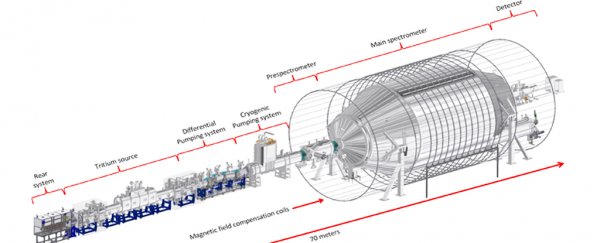A huge experiment to pin down the mass of one of the Universe's most perplexing particles has put a cap on how big the neutrino might actually be.
Once considered massless, the particle's mass is now thought to weigh no more than a single electronvolt. It might not be a precise answer, but it does bring us a step closer to a satisfying solution for one of modern physics' biggest mysteries.
Neutrinos are strange. They're among the most abundant particles in the Universe, and yet are hard to detect. Due to their unique properties, they interact very little with normal matter as they stream through the Universe at near light-speed.
Billions of neutrinos are zipping through your body right now. You can see why they are called 'ghost particles'.
The Karlsruhe Tritium Neutrino (KATRIN) experiment began its campaign of tests to calculate the resting mass of the neutrino last spring, after years of calibrations and testing of their facility in Germany.
Earlier this month, representatives from the collaboration delivered their first lot of results at a conference in Japan.
While there's still a way to go, and the findings have not yet been published, the team's efforts have halved mass estimates previously considered as possible, down from the previous upper limit of around 2 electronvolts to just 1.
Unlike units of pounds and kilograms, this measurement isn't an easy one to picture. MIT physicist Joseph Formaggio and leading member of the KATRIN experimental group suggests starting tiny, and then going smaller.
"Each virus is made up of roughly 10 million protons," Formaggio explained to MIT News writer, Jennifer Chu.
"Each proton weighs about 2,000 times more than each electron inside that virus. And what our results showed is that the neutrino has a mass less than 1/500,000 of a single electron!"
As it happens, nobody is surprised that the base mass of a neutrino may be so inconceivably low. In fact, when they were first suggested as part of the Standard Model of particle physics, it was assumed the particles didn't have any mass at all.
This assumption was empirically challenged in the late 1990s by the results of a landmark experiment demonstrating neutrinos streaming from the Sun changed form, or flavour, in a way that meant their mass couldn't be zero.
So if it's not zero, what is it? For more than two decades, various experiments have done their best to constrain the limits on just how big – or small – it might be.
The problem is that neutrinos mind their own business in a rather effective way. The only interaction they have with the kinds of particles we build measuring tools from is via the weak nuclear force, which isn't exactly an easy force to detect.
"If you filled the Solar System with lead out to fifty times beyond the orbit of Pluto, about half of the neutrinos emitted by the Sun would still leave the Solar System without interacting with that lead," says University of Washington physicist, Hamish Robertson.
Because of this, physicists have to look for less direct methods to carry out observations on such a ghostly particle.
Astronomical observations have suggested the particles have a mass of at least 0.02 electronvolts. Other experiments based on the vast shower of electrons released by crumbling atoms of tritium have suggested it can't be more than 2.2 electronvolts.
KATRIN picks up where those last upper-limit estimates left off, upscaling the search for an answer in tritium's decay by keeping a careful watch on the radioactive gas inside a 70-metre-long piece of equipment.
When the hydrogen isotope breaks down (or decays), it can release a rather energetic pair of particles in the form of an electron plus an antineutrino.
Since physicists are confident the mass of a neutrino is the same as its antiparticle, the decay provides a prime opportunity for making a precise measurement.
Usually, the 18,560 electron volts of energy that sends the electron flying is shared fairly equally with the antineutrino.
If you remember the classic E=mc2 formula, mass and energy are two sides of the same coin. An accelerating antineutrino has a kick of kinetic energy that counts towards its mass.
But it's the non-accelerating energy of the elusive particle physicists are interested in. So they need to sift through a multitude of decay events to find the few that give the electron most of the energy.
What remains of that shared energy – theoretically – should set the limit on how heavy a resting neutrino could be.
Luckily their source of tritium churns out around 25 billion pairs of the two particles every second. And at least some are sure to have the greedy electrons and undernourished antineutrinos they need.
Getting this number down to a precise figure would help inform a wide variety of physics that still has us scratching our head, from the nature of dark matter to an explanation of why 'stuff' exists at all.
"Neutrinos are strange little particles," says physicist Peter Doe from the University of Washington.
"They're so ubiquitous, and there's so much we can learn once we determine this value."
